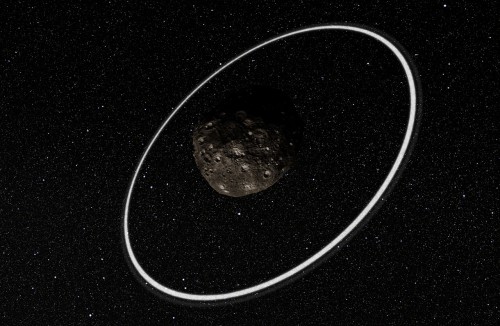
When it comes to planetary rings, what do you think of? Saturn is the first obvious thing that comes to mind, with its famous majestic ring system surrounding the gas giant planet. The other gas and ice giants – Jupiter, Uranus and Neptune – also have rings, although not as spectacular as Saturn’s. The smaller rocky planets in our solar system are all lacking rings unfortunately. But now, a new set of rings has been discovered for the first time – not around a planet, but an asteroid!
The surprising discovery was announced yesterday, March 26, 2014, by astronomers from the European Southern Observatory (ESO). It was made using seven different telescopes in South America, including the 1.54-metre Danish and TRAPPIST telescopes at ESO’s La Silla Observatory in Chile. They were watching the asteroid pass in front of the star UCAC4 248-108672 on June 3, 2013 for a predicted occultation. This occultation allowed astronomers to see two tiny dips in the star’s brightness as the asteroid moved in front of it, a few seconds just before and just after the main occultation.

“We weren’t looking for a ring and didn’t think small bodies like Chariklo had them at all, so the discovery – and the amazing amount of detail we saw in the system – came as a complete surprise!” said Felipe Braga-Ribas of the Observatório Nacional/MCTI in Rio de Janeiro, Brazil). He is also the lead author of the new paper just published today in Nature.
The asteroid, named Chariklo, is the largest of a group of asteroids known as the Centaurs, about 155 miles (250 kilometres) in diameter, orbiting the Sun out past the orbit of Saturn. Two distinct narrow and dense rings were discovered, 4.3 and 1.9 miles (7 and 3 kilometres) wide, separated by a gap of about 5.6 miles (9 kilometres).

As team member Uffe Gråe Jørgensen added, “For me, it was quite amazing to realise that we were able not only to detect a ring system, but also pinpoint that it consists of two clearly distinct rings. I try to imagine how it would be to stand on the surface of this icy object – small enough that a fast sports car could reach escape velocity and drive off into space – and stare up at a 20-kilometre wide ring system 1000 times closer than the Moon.”
It’s still a mystery as to how these rings formed around such a small body, but the current theory is that they are debris left over from a collision with another asteroid or comet. Researchers in the project have also given the rings provisional names – Oiapoque and Chuí, for two rivers near the northern and southern ends of Brazil.
It is also speculated that Chariklo may have at least one tiny moon also waiting to be discovered.
Perhaps one day in the not-too-distant future, a spacecraft will be able to see Chariklo and its rings up close. Until then, we will have to make do with the information we have. Chariklo is so small and distant, it is not much more than a point of light even in the best telescopes.
The discovery continues to show how surprising and complex our solar system can be. Some other asteroids have already been found to have their own tiny moons, and now this is the first one known to have rings. It seems likely that there are others as well, waiting to be found. What else is out there?
The published paper in Nature is available here.
Want to keep up-to-date with all things space? Be sure to “Like” AmericaSpace on Facebook and follow us on Twitter:@AmericaSpace




Cant wait for a mission to Chariklo!
Excellent website you have here but I was curious if you knew of any community forums
that cover the same topics discussed in this article?
I’d really love to be a part of online community where I can get feedback from other experienced
people that share the same interest. If you have any suggestions, please let
me know. Thank you!